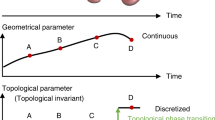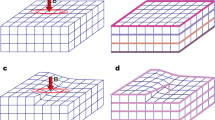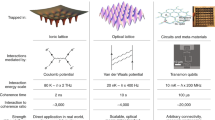Abstract
Topological phases enable protected transport along the edges of materials, offering immunity against scattering from disorder and imperfections. These phases have been demonstrated for electronic systems, electromagnetic waves1,2,3,4,5, cold atoms6,7, acoustics8 and even mechanics9, and their potential applications include spintronics, quantum computing and highly efficient lasers10,11,12. Typically, the model describing topological insulators is a spatial lattice in two or three dimensions. However, topological edge states have also been observed in a lattice with one spatial dimension and one synthetic dimension (corresponding to the spin modes of an ultracold atom13,14,15), and atomic modes have been used as synthetic dimensions to demonstrate lattice models and physical phenomena that are not accessible to experiments in spatial lattices13,16,17. In photonics, topological lattices with synthetic dimensions have been proposed for the study of physical phenomena in high dimensions and interacting photons18,19,20,21,22, but so far photonic topological insulators in synthetic dimensions have not been observed. Here we demonstrate experimentally a photonic topological insulator in synthetic dimensions. We fabricate a photonic lattice in which photons are subjected to an effective magnetic field in a space with one spatial dimension and one synthetic modal dimension. Our scheme supports topological edge states in this spatial-modal lattice, resulting in a robust topological state that extends over the bulk of a two-dimensional real-space lattice. Our system can be used to increase the dimensionality of a photonic lattice and induce long-range coupling by design, leading to lattice models that can be used to study unexplored physical phenomena.
This is a preview of subscription content, access via your institution
Access options
Access Nature and 54 other Nature Portfolio journals
Get Nature+, our best-value online-access subscription
$29.99 / 30 days
cancel any time
Subscribe to this journal
Receive 51 print issues and online access
$199.00 per year
only $3.90 per issue
Buy this article
- Purchase on Springer Link
- Instant access to full article PDF
Prices may be subject to local taxes which are calculated during checkout




Similar content being viewed by others
Data availability
The data that support the findings of this study are available from the corresponding author upon reasonable request.
References
Haldane, F. D. M. & Raghu, S. Possible realization of directional optical waveguides in photonic crystals with broken time-reversal symmetry. Phys. Rev. Lett. 100, 013904 (2008).
Wang, Z., Chong, Y., Joannopoulos, J. D. & Soljačić, M. Observation of unidirectional backscattering-immune topological electromagnetic states. Nature 461, 772–775 (2009).
Malkova, N., Hromada, I., Wang, X., Bryant, G. & Chen, Z. Observation of optical Shockley-like surface states in photonic superlattices. Opt. Lett. 34, 1633–1635 (2009).
Rechtsman, M. C. et al. Photonic Floquet topological insulators. Nature 496, 196–200 (2013).
Hafezi, M., Mittal, S., Fan, J., Migdall, A. & Taylor, J. M. Imaging topological edge states in silicon photonics. Nat. Photon. 7, 1001–1005 (2013).
Jotzu, G. et al. Experimental realization of the topological Haldane model with ultracold fermions. Nature 515, 237 (2014).
Aidelsburger, M. et al. Measuring the Chern number of Hofstadter bands with ultracold bosonic atoms. Nat. Phys. 11, 162–166 (2015).
He, C. et al. Acoustic topological insulator and robust one-way sound transport. Nat. Phys. 12, 1124–1129 (2016).
Süsstrunk, R. & Huber, S. D. Observation of phononic helical edge states in a mechanical topological insulator. Science 349, 47–50 (2015).
Bahari, B. et al. Nonreciprocal lasing in topological cavities of arbitrary geometries. Science 358, 636–640 (2017).
Harari, G. et al. Topological insulator laser: theory. Science 359, eaar4003 (2018).
Bandres, M. A. et al. Topological insulator laser: experiments. Science 359, eaar4005 (2018).
Celi, A. et al. Synthetic gauge fields in synthetic dimensions. Phys. Rev. Lett. 112, 043001 (2014).
Mancini, M. et al. Observation of chiral edge states with neutral fermions in synthetic Hall ribbons. Science 349, 1510–1513 (2015).
Stuhl, B. K., Lu, H.-I., Aycock, L. M., Genkina, D. & Spielman, I. B. Visualizing edge states with an atomic Bose gas in the quantum Hall regime. Science 349, 1514–1518 (2015).
Boada, O., Celi, A., Latorre, J. I. & Lewenstein, M. Quantum simulation of an extra dimension. Phys. Rev. Lett. 108, 133001 (2012).
Price, H. M., Zilberberg, O., Ozawa, T., Carusotto, I. & Goldman, N. Four-dimensional quantum Hall effect with ultracold atoms. Phys. Rev. Lett. 115, 195303 (2015).
Jukić, D. & Buljan, H. Four-dimensional photonic lattices and discrete tesseract solitons. Phys. Rev. A 87, 013814 (2013).
Luo, X.-W. et al. Quantum simulation of 2D topological physics in a 1D array of optical cavities. Nat. Commun. 6, 7704 (2015).
Yuan, L., Shi, Y. & Fan, S. Photonic gauge potential in a system with a synthetic frequency dimension. Opt. Lett. 41, 741–744 (2016).
Ozawa, T., Price, H. M., Goldman, N., Zilberberg, O. & Carusotto, I. Synthetic dimensions in integrated photonics: from optical isolation to four-dimensional quantum Hall physics. Phys. Rev. A 93, 043827 (2016).
Yuan, L., Lin, Q., Xiao, M. & Fan, S. Synthetic dimension in photonics. Optica 5, 1396–1405 (2018).
Genkina, D. et al. Imaging topology of Hofstadter ribbons. Preprint at https://arxiv.org/abs/1804.06345 (2018).
Kolkowitz, S. et al. Spin–orbit-coupled fermions in an optical lattice clock. Nature 542, 66–70 (2017).
An, F. A., Meier, E. J. & Gadway, B. Direct observation of chiral currents and magnetic reflection in atomic flux lattices. Sci. Adv. 3, e1602685 (2017).
Price, H. M., Ozawa, T. & Goldman, N. Synthetic dimensions for cold atoms from shaking a harmonic trap. Phys. Rev. A 95, 023607 (2017).
Zilberberg, O. et al. Photonic topological boundary pumping as a probe of 4D quantum Hall physics. Nature 553, 59–62 (2018).
Weimann, S. et al. Implementation of quantum and classical discrete fractional Fourier transforms. Nat. Commun. 7, 11027 (2016).
Perez-Leija, A., Keil, R., Kay, A., Moya-Cessa, H., Nolte, S., Kwek, L.-C., Rodríguez-Lara, B. M., Szameit, A. & Christodoulides, D. N. Coherent quantum transport in photonic lattices. Phys. Rev. A 87, 012309 (2013).
Makris, K. G., El-Ganainy, R., Christodoulides, D. N. & Musslimani, Z. H. Beam dynamics in PT symmetric optical lattices. Phys. Rev. Lett. 100, 103904 (2008).
Rüter, C. E. et al. Observation of parity–time symmetry in optics. Nat. Phys. 6, 192 (2010).
Klaiman, S., Günther, U. & Moiseyev, N. Visualization of branch points in PT-symmetric waveguides. Phys. Rev. Lett. 101, 080402 (2008).
Lu, L., Gao, H. & Wang, Z. Topological one-way fiber of second Chern number. Nat. Commun. 9, 5384 (2018).
Livi, L. F. et al. Synthetic dimensions and spin–orbit coupling with an optical clock transition. Phys. Rev. Lett. 117, 220401 (2016).
Fang, K. et al. Generalized non-reciprocity in an optomechanical circuit via synthetic magnetism and reservoir engineering. Nat. Phys. 13, 465–471 (2017).
Price, H. M., Ozawa, T. & Carusotto, I. Quantum mechanics with a momentum-space artificial magnetic field. Phys. Rev. Lett. 113, 190403 (2014).
Suszalski, D. & Zakrzewski, J. Different lattice geometries with a synthetic dimension. Phys. Rev. A 94, 033602 (2016).
Goldman, N., Budich, J. C. & Zoller, P. Topological quantum matter with ultracold gases in optical lattices. Nat. Phys. 12, 639–645 (2016).
Bell, B. A. et al. Spectral photonic lattices with complex long-range coupling. Optica 4, 1433–1436 (2017).
Ge, L. & Stone, A. D. Parity–time symmetry breaking beyond one dimension: the role of degeneracy. Phys. Rev. X 4, 031011 (2014).
Bender, C. M., Hassanpour, N., Klevansky, S. P. & Sarkar, S. PT-symmetric quantum field theory in D dimensions. Phys. Rev. D 98, 125003 (2018).
Kremer, M., Biesenthal, T., Heinrich, M., Thomale, R. & Szameit, A. Demonstration of a two-dimensional PT-symmetric crystal: bulk dynamics, topology, and edge states. Preprint at http://arxiv.org/abs/1809.00041 (2018).
Hodaei, H. et al. Enhanced sensitivity at higher-order exceptional points. Nature 548, 187–191 (2017).
Lin, Z. et al. Unidirectional invisibility induced by PT-symmetric periodic structures. Phys. Rev. Lett. 106, 213901 (2011).
Schwartz, T., Bartal, G., Fishman, S. & Segev, M. Transport and Anderson localization in disordered two-dimensional photonic lattices. Nature 446, 52–55 (2007).
Klembt, S. et al. Exciton-polariton topological insulator. Nature 562, 552–556 (2018).
Noh, J. et al. Experimental observation of optical Weyl points and Fermi arc-like surface states. Nat. Phys. 13, 611–617 (2017).
Martin, I., Refael, G. & Halperin, B. Topological frequency conversion in strongly driven quantum systems. Phys. Rev. X 7, 041008 (2017).
Yuan, L., Xiao, M., Lin, Q. & Fan, S. Synthetic space with arbitrary dimensions in a few rings undergoing dynamic modulation. Phys. Rev. B 97, 104105 (2018).
Loring, T. A. & Hastings, M. B. Disordered topological insulators via C*-algebras. Europhys. Lett. 92, 67004 (2010).
Szameit, A. et al. Discrete optics in femtosecond-laser-written photonic structures. J. Phys. At. Mol. Opt. Phys. 43, 163001 (2010).
Acknowledgements
This work was supported by the German–Israeli DIP Program, by an Advanced Grant from the European Research Council and by the Israel Science Foundation. E.L. is grateful for the support of the Israel Academy of Sciences through an Adams Fellowship.
Reviewer information
Nature thanks Ling Lu and the other anonymous reviewer(s) for their contribution to the peer review of this work.
Author information
Authors and Affiliations
Contributions
All authors contributed significantly to this work.
Corresponding author
Ethics declarations
Competing interests
The authors declare no competing interests.
Additional information
Publisher’s note: Springer Nature remains neutral with regard to jurisdictional claims in published maps and institutional affiliations.
Extended data figures and tables
Extended Data Fig. 1 Increasing the dimensionality of a two-dimensional lattice of waveguides.
a, One-dimensional columns arranged in a two-dimensional lattice. The columns oscillate along the black paths in the direction indicated by the triangles. Red and blue colours indicate different columns in the same unit cell. b, Representation of a in synthetic dimensions. c, Lattice with two oscillation frequencies, oscillating in the x direction according to Δx and with index of refraction changing periodically according to Δn. d, Representation of c in synthetic dimensions.
Extended Data Fig. 2 Light occupancy in the leftmost column when a Gaussian beam is launched from the middle of the lattice.
a, b, Illustrated intensity (colour bar; peak intensity is set to 1) of the initial Gaussian beam launched in real space (a) and synthetic space (b). c, Measured output intensity of the leftmost column for the input shown in a and b. d, Measured interference of the lattice output at the leftmost column with the input beam, showing that all of the seven peaks are in phase (the dashed line represents equal phase), indicating that the light at the leftmost column occupies the lowest spatial mode of the column. e, Measured normalized intensity cross-section (blue line) at the leftmost column of the lattice output, compared with the theoretically calculated (tight-binding) intensity profile of the first mode of the column (orange circles). The sum of peak intensities is normalized to 1.
Extended Data Fig. 3 Light occupancy in the leftmost column when a Gaussian beam is launched from the left side of the lattice.
a, b, Illustrated intensity pattern (colour bar) of the initial Gaussian beam launched in real space (a) and in synthetic space (b). c, Measured intensity distribution at the leftmost column. d, Measured interference pattern at the lattice output at the leftmost column, showing that, unlike in Extended Data Fig. 2d, the seven intensity peaks are not in phase and therefore occupy higher modes of the array. e, Zoom-in on the red rectangle in d, showing that the light peaks are not aligned on the equal-phase line (dashed line). f, Cross-section (blue line) of the intensity pattern at the leftmost column of the lattice output, compared with the calculated intensity profile of the first mode (orange circles) where the sum of peak intensities is normalized to 1. The mismatch shows that the light is occupying modes higher than the first mode.
Extended Data Fig. 4 Floquet spectrum of equation (1).
a, Eigenvalues obtained numerically for a 20 × 20 site, displaying two topological gaps. b, Real-space amplitude distribution of an eigenstate residing in the gap (edge state marked in a). c, The same eigenstate as in b as it appears in synthetic space (unitary transformation of b), showing clearly that the marked state is an edge state. The parameters used are R = 5 μm, Ω = 69.1448 m−1, coupling in y cy = 10.9431 m−1 and k0 = 1.9 × 107 m−1.
Extended Data Fig. 5 Disorder in synthetic space.
a, Typical disorder introduced to the Hamiltonian of a one-dimensional lattice. The Hamiltonian is in real-space matrix representation (the colour bar corresponds to the real part of the value of the matrix element). b, The disorder shown in a after transformation to synthetic space. c, Standard deviation and mean value of the Bott index averaged over 10 random disorder realizations for the regular topological insulator (blue line) and for the topological insulator in synthetic dimensions (red line). The red bracket indicates half of the bandgap. d, e, A disorder (black sites) that is confined spatially in real space is not confined in synthetic space (blue sites).
Extended Data Fig. 6 Exciting the anticlockwise edge state.
a, Initial excitation of the first mode in the rightmost column of the topological lattice. b, Output intensity (colour bar) corresponding to a. c, Direction of propagation of the light in synthetic space. d–f, The same as a–c, but for the trivial lattice. CW, clockwise; ACW, anticlockwise.
Extended Data Fig. 7 Experimental results for a sample fabricated with different parameters.
Illustration of an incident narrow Gaussian beam directed towards the input facet of a synthetic-space topological lattice fabricated with parameters different from those used in the experiments presented in the main text (here, ϕ = π/4, Ω = 91 m−1 and R = 17.5 μm). a, b, Input beam launched at different locations in real space (a) and synthetic space (b). c, d, Experimentally imaged (c) and simulated (d) beam intensity at the output facet of the lattice. e, Synthetic-space description corresponding to the evolution of the wavepacket as it propagates in the lattice.
Extended Data Fig. 8 Stages in the preparation of the experimental model.
a, Horizontal cross-section of the intensity of a propagating mode of a single waveguide (orange line) and the cross-section of the mode in the simulations (blue line). The image on the right is the intensity distribution of the mode in the direction of the cross-section. b, Same as a, but for the vertical cross-section of the propagating mode of a single waveguide. c, Coupling versus distance in the horizontal direction. d, Coupling versus distance in the vertical direction. e, Mode propagation constants of the Jx lattice based on measured experimental parameters (blue circles). The dashed line is a guide for the eye.
Supplementary information
Supplementary Information
This file contains Supplementary Text regarding analytic derivation of the lattice in synthetic dimensions.
Rights and permissions
About this article
Cite this article
Lustig, E., Weimann, S., Plotnik, Y. et al. Photonic topological insulator in synthetic dimensions. Nature 567, 356–360 (2019). https://doi.org/10.1038/s41586-019-0943-7
Received:
Accepted:
Published:
Issue Date:
DOI: https://doi.org/10.1038/s41586-019-0943-7
This article is cited by
-
Realization of all-band-flat photonic lattices
Nature Communications (2024)
-
Discrete nonlinear topological photonics
Nature Physics (2024)
-
Quantized topological pumping in Floquet synthetic dimensions with a driven dissipative photonic molecule
Nature Physics (2024)
-
A von-Neumann-like photonic processor and its application in studying quantum signature of chaos
Light: Science & Applications (2024)
-
Thouless pumping and topology
Nature Reviews Physics (2023)
Comments
By submitting a comment you agree to abide by our Terms and Community Guidelines. If you find something abusive or that does not comply with our terms or guidelines please flag it as inappropriate.



